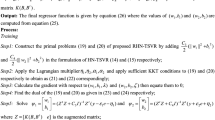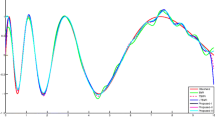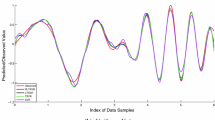Abstract
In twin support vector regression (TSVR), one can notice that the samples are having the same importance even they are laying above the up-bound and below the down-bound on the estimation function for regression problem. Instead of giving the same emphasis to the samples, a novel approach Asymmetric ν-twin support vector regression (Asy-ν-TSVR) is suggested in this context where samples are having different influences with the estimation function based on samples distribution. Inspired by this concept, in this paper, we propose a new approach as improved regularization based Lagrangian asymmetric ν-twin support vector regression using pinball loss function (LAsy-ν-TSVR) which is more effective and efficient to deal with the outliers and noise. The solution is obtained by solving the simple linearly convergent approach which reduces the computational complexity of the proposed LAsy-ν-TSVR. Also, the structural risk minimization principle is implemented to make the problem strongly convex and more stable by adding the regularization term in their objective functions. The superiority of proposed LAsy-ν-TSVR is justified by performing the various numerical experiments on artificial generated datasets with symmetric and heteroscedastic structure noise as well as standard real-world datasets. The results of LAsy-ν-TSVR compares with support vector regression (SVR), TSVR, TSVR with Huber loss (HN-TSVR) and Asy-ν-TSVR, regularization on Lagrangian TSVR (RLTSVR) for the linear and Gaussian kernel which clearly demonstrates the efficacy and efficiency of the proposed algorithm LAsy-ν-TSVR.










Similar content being viewed by others
References
Cortes C, Vapnik V (1995) Support-vector networks. Mach Learn 20(3):273–297
Drucker H, Burges CJC, Kaufman L, Smola AJ, Vapnik V (1997) Support vector regression machines." In Advances in neural information processing systems, pp. 155–161
Trzciński T, Rokita P (2017) Predicting popularity of online videos using support vector regression. IEEE Trans Multimedia 19(11):2561–2570
López-Martín C, Ulloa-Cazarez RL, García-Floriano A (2017) Support vector regression for predicting the productivity of higher education graduate students from individually developed software projects. IET Softw 11(5):265–270
Golkarnarenji G, Naebe M, Badii K, Milani AS, Jazar RN, Khayyam H (2018) Support vector regression modelling and optimization of energy consumption in carbon fiber production line. Comput Chem Eng 109:276–288
García-Floriano A, López-Martín C, Yáñez-Márquez C, Abran A (2018) Support vector regression for predicting software enhancement effort. Inf Softw Technol 97:99–109
Dong Y, Zhang Z, Hong W-C (2018) A hybrid seasonal mechanism with a chaotic cuckoo search algorithm with a support vector regression model for electric load forecasting. Energies 11(4):1009
Khosravi A, Koury RNN, Machado L, Pabon JJG (2018) Prediction of wind speed and wind direction using artificial neural network, support vector regression and adaptive neuro-fuzzy inference system. Sustainable Energy Technol Assess 25:146–160
Baydaroğlu Ö, Koçak K, Duran K (2018) River flow prediction using hybrid models of support vector regression with the wavelet transform, singular spectrum analysis and chaotic approach. Meteorog Atmos Phys 130(3):349–359
Xiao X, Zhang T, Zhong X, Shao W, Li X (2018) Support vector regression snow-depth retrieval algorithm using passive microwave remote sensing data. Remote Sens Environ 210:48–64
Fisher DM, Kelly RF, Patel DR, Gilmore M (2018) A support vector regression method for efficiently determining neutral profiles from laser induced fluorescence data. Rev Sci Instrum 89(10):10C104
Zhang J, Teng Y-F, Chen W (2018) Support vector regression with modified firefly algorithm for stock price forecasting. Appl Intell:1–17
Schölkopf B, Smola AJ, Williamson RC, Bartlett PL (2000) New support vector algorithms. Neural Comput 12(5):1207–1245
Collobert R, Bengio S (2001) SVMTorch: support vector machines for large-scale regression problems. J Mach Learn Res 1:143–160
Law MHC, Kwok JT-Y (2001) Bayesian Support Vector Regression. AISTATS
Bi J, Bennett KP (2003) A geometric approach to support vector regression. Neurocomputing 55(1–2):79–108
Musicant DR, Feinberg A (2004) Active set support vector regression. IEEE Trans Neural Netw 15(2):268–275
Wang W, Xu Z (2004) A heuristic training for support vector regression. Neurocomputing 61:259–275
Lee Y-J, Hsieh W-F, Huang C-M (2005) ε-SSVR: a smooth support vector machine for ε-insensitive regression. IEEE Trans Knowl Data Eng 17(5):678–685
Chuang C-C (2007) Fuzzy weighted support vector regression with a fuzzy partition. IEEE Trans Syst Man Cybern B 37(3):630–640
Jayadeva, Khemchandani R, Chandra S (2007) Twin support vector machines for pattern classification. IEEE Trans Pattern Anal Mach Intell 29(5):905–910
Peng X (2010) TSVR: an efficient twin support vector machine for regression. Neural Netw 23(3):365–372
Singh M, Chadha J, Ahuja P, Chandra S (2011) Reduced twin support vector regression. Neurocomputing 74(9):1474–1477
Xu Y, Wang L (2012) A weighted twin support vector regression. Knowl-Based Syst 33:92–101
Zhao Y-P, Zhao J, Zhao M (2013) Twin least squares support vector regression. Neurocomputing 118:225–236
Suykens JAK, Vandewalle J (1999) Least squares support vector machine classifiers. Neural Process Lett 9(3):293–300
Balasundaram S, Tanveer M (2013) On Lagrangian twin support vector regression. Neural Comput & Applic 22(1):257–267
Balasundaram S, Gupta D (2014) Training Lagrangian twin support vector regression via unconstrained convex minimization. Knowl-Based Syst 59:85–96
Niu J, Chen J, Xu Y (2017) Twin support vector regression with Huber loss. J Intell Fuzzy Syst 32(6):4247–4258
Tanveer M, Shubham K (2017) A regularization on Lagrangian twin support vector regression. Int J Mach Learn Cybern 8(3):807–821
Huang X, Shi L, Suykens JAK (2014a) Support vector machine classifier with pinball loss.". IEEE Trans Pattern Anal Mach Intell 36(5):984–997
Huang X, Shi L, Suykens JAK (2015) Sequential minimal optimization for SVM with pinball loss. Neurocomputing 149:1596–1603
Xu Y, Yang Z, Zhang Y, Pan X, Wang L (2016) A maximum margin and minimum volume hyper-spheres machine with pinball loss for imbalanced data classification. Knowl-Based Syst 95:75–85
Peng X, Xu D (2013) A twin-hypersphere support vector machine classifier and the fast learning algorithm. Inf Sci 221:12–27
Xu Y, Yang Z, Pan X (2017) A novel twin support-vector machine with pinball loss. IEEE Transactions on Neural Networks and Learning Systems 28(2):359–370
Nandan Sengupta R (2008) Use of asymmetric loss functions in sequential estimation problems for multiple linear regression. J Appl Stat 35(3):245–261
Reed C, Yu K (2009) A partially collapsed Gibbs sampler for Bayesian quantile regression
Le Masne Q, Pothier H, Birge NO, Urbina C, Esteve D (2009) Asymmetric noise probed with a Josephson junction. Phys Rev Lett 102(6):067002
Hao P-Y (2010) New support vector algorithms with parametric insensitive/margin model. Neural Netw 23(1):60–73
Steinwart I, Christmann A (2011) Estimating conditional quantiles with the help of the pinball loss. Bernoulli 17(1):211–225
Xu Y, Guo R (2014) An improved ν-twin support vector machine. Appl Intell 41(1):42–54
Rastogi R, Anand P, Chandra S (2017) A ν-twin support vector machine based regression with automatic accuracy control. Appl Intell 46(3):670–683
Demšar J (2006) Statistical comparisons of classifiers over multiple data sets. J Mach Learn Res 7:1–30
Xu Y, Li X, Pan X, Yang Z (2018) Asymmetric ν-twin support vector regression. Neural Comput & Applic 30(12):3799–3814
Huang X, Shi L, Pelckmans K, Suykens JAK (2014b) Asymmetric ν-tube support vector regression. Comput Stat Data Anal 77:371–382
Cristianini N, Shawe-Taylor J (2000) An introduction to support vector machines and other kernel-based learning methods. Cambridge university press, Cambridge
Huber PJ (1964) Robust estimation of a location parameter. Ann Math Stat 35(1):73–101
Mangasarian OL, Musicant DR (2000) Robust linear and support vector regression. IEEE Trans Pattern Anal Mach Intell 22(9):950–955
Mangasarian OL (1994) Nonlinear programming. SIAM, Philadelphia
Mangasarian OL, Musicant DR (2001) Lagrangian support vector machines. J Mach Learn Res 1:161–177
Mosek.com (2018) ‘MOSEK optimization software for solving QPPs.’[online]. Available: https://www.mosek.com
StatLib (2018) ‘StatLib, Carnegie Mellon University.’ [online]. Available: http://lib.stat.cmu.edu/datasets
DELVE (2018) ‘DELVE, University of California.’ [online]. Available: https://www.cs.toronto.edu/~delve/
DaISy (2018) ‘DaISY: Database for the Identification of Systems, Department of Electrical Engineering, ESAT/STADIUS, KU Leuven, Belgium.’ [online]. Available: http://homes.esat.kuleuven.be/~smc/daisydata.html
Yahoo Finance (2018) ‘Yahoo Finance.’ [online] Available: http://finance.yahoo.com/
Lichman M (2018) “UCI Machine Learning Repository. Irvine, University of California, Irvine, School of Information and Computer Sciences. (2013). 02–14. Available: https://archive.ics.uci.edu/ml/
Casdagli M (1989) Nonlinear prediction of chaotic time series. Physica D 35(3):335–356
Xu Y (2012) A rough margin-based linear ν support vector regression. Statistics & Probability Letters 82(3):528–534
Author information
Authors and Affiliations
Corresponding author
Additional information
Publisher’s note
Springer Nature remains neutral with regard to jurisdictional claims in published maps and institutional affiliations.
Rights and permissions
About this article
Cite this article
Gupta, U., Gupta, D. An improved regularization based Lagrangian asymmetric ν-twin support vector regression using pinball loss function. Appl Intell 49, 3606–3627 (2019). https://doi.org/10.1007/s10489-019-01465-w
Published:
Issue Date:
DOI: https://doi.org/10.1007/s10489-019-01465-w




